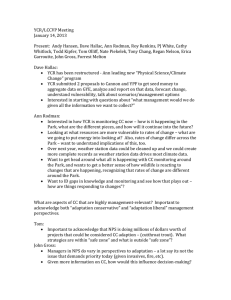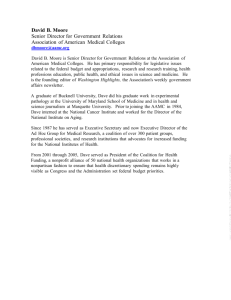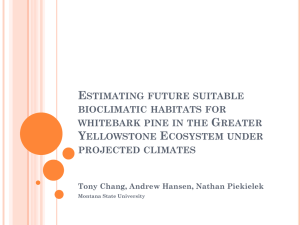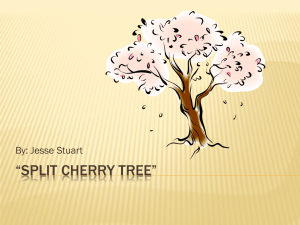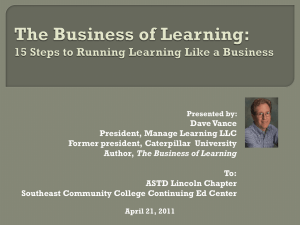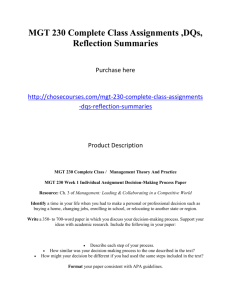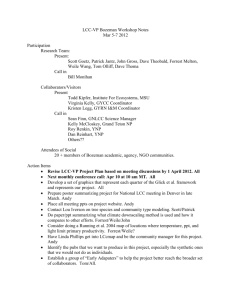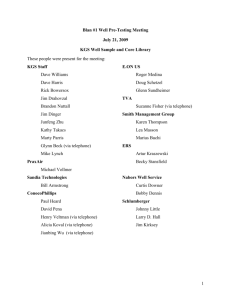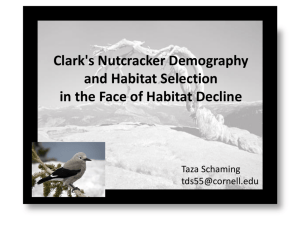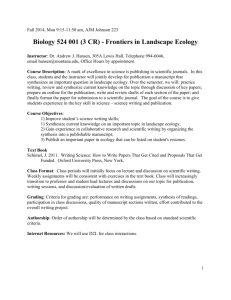Meeting notes.doc - Montana State University
advertisement
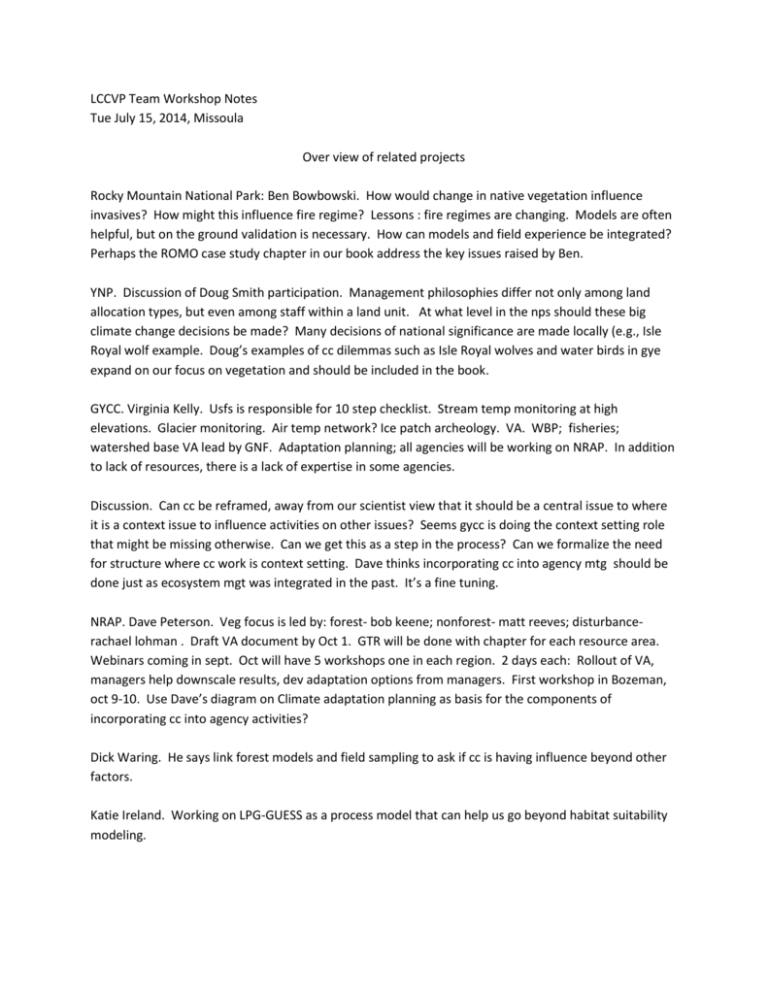
LCCVP Team Workshop Notes Tue July 15, 2014, Missoula Over view of related projects Rocky Mountain National Park: Ben Bowbowski. How would change in native vegetation influence invasives? How might this influence fire regime? Lessons : fire regimes are changing. Models are often helpful, but on the ground validation is necessary. How can models and field experience be integrated? Perhaps the ROMO case study chapter in our book address the key issues raised by Ben. YNP. Discussion of Doug Smith participation. Management philosophies differ not only among land allocation types, but even among staff within a land unit. At what level in the nps should these big climate change decisions be made? Many decisions of national significance are made locally (e.g., Isle Royal wolf example. Doug’s examples of cc dilemmas such as Isle Royal wolves and water birds in gye expand on our focus on vegetation and should be included in the book. GYCC. Virginia Kelly. Usfs is responsible for 10 step checklist. Stream temp monitoring at high elevations. Glacier monitoring. Air temp network? Ice patch archeology. VA. WBP; fisheries; watershed base VA lead by GNF. Adaptation planning; all agencies will be working on NRAP. In addition to lack of resources, there is a lack of expertise in some agencies. Discussion. Can cc be reframed, away from our scientist view that it should be a central issue to where it is a context issue to influence activities on other issues? Seems gycc is doing the context setting role that might be missing otherwise. Can we get this as a step in the process? Can we formalize the need for structure where cc work is context setting. Dave thinks incorporating cc into agency mtg should be done just as ecosystem mgt was integrated in the past. It’s a fine tuning. NRAP. Dave Peterson. Veg focus is led by: forest- bob keene; nonforest- matt reeves; disturbancerachael lohman . Draft VA document by Oct 1. GTR will be done with chapter for each resource area. Webinars coming in sept. Oct will have 5 workshops one in each region. 2 days each: Rollout of VA, managers help downscale results, dev adaptation options from managers. First workshop in Bozeman, oct 9-10. Use Dave’s diagram on Climate adaptation planning as basis for the components of incorporating cc into agency activities? Dick Waring. He says link forest models and field sampling to ask if cc is having influence beyond other factors. Katie Ireland. Working on LPG-GUESS as a process model that can help us go beyond habitat suitability modeling. Vegetation Vulnerability / Management Workshop Suggestions from Dave Pederson. Process is key to success. Get key work done in advance. Keep NRAP leads in the loop. Provide in advance key information and synthesis. Process/format Preworkshop Summarize work to date in Resource Briefs and other products (we could get review on them at the same time) Develop pilot scheme for VA and strawman entries (engage partners now) Webinar to introduce strawman VA to the participants Workshop Introduction Context for meeting Individual group assignments How it all will blend to meeting goals and objectives All aspects of climate adaption planning, not just active mgt, including interpretation and communication (including documenting the issue and sharing with the public). Review NRAP conclusions Lead managers activities Review the options/activities Provide examples Discuss overlap of CAP and regular agency planning and activities Ask them for opportunities and constraints and how to overcome them (candid conversation on how to go forward successfully) Include how scenario planning fits into this So what? What if we do nothing? VA folks activities Go back thru VA and refine Come with final VA ranking Climate adaptation planning (CAP) folks What are the types of CAP options? What are good options for the species identified as most vulnerable. Location Bozeman in February 2015 VA approach To be developed. Participants Types of people Ecologist Forester/Silviculture Scientist Lead administrators Agencies Usfs Blm nps Locations Rocky Superintendent, Ben, Isabel Ashton (research learning center director), Wyoming basin Bob means (BLM), reass mgt team, tosha carr (USGS) Gye Crown CMP, chip webber (flathead NF), usfs forester from the flathead High Divide Products Next steps Andy, Bill, Patrick, Dave will take lead on how to do the VA Ben and Tom will take lead on the lead administrators component. LCCVP Year-Four Activities and Book Complete research and resource briefs before February VA / management workshop, if possible. Do a VA / management workshop in the east in summer 2015, similar to the Feb workshop in the west. Have an informal meeting with NPS I&M and the North Central Climate Science Center to discuss hand off of decision support products in September 2014. Book schedule Prospectus to Island Press Aug 1 Outlines Aug 1 First drafts Oct 15 Second drafts Nov 15 Friendly review Final Feb 1 Include Management collaborators perspectives in case study chapters, in sidebar essays, or some other means. Notes on meeting with Island Press Length. 90000 words max with text and references. Keep a book under 300 pgs. This is ca 5300 words per each of 17 chapters. Format. Use similar formats among chapters. Have ca 2-3 color graphics per chapter as an upper limit. Have similar number of graphics in each chapter. Set standards for references. Put them at the end of each chapter or at the end of the book. Highlighted boxes (e.g., managers essays) need to fit on one page. Prospectus. List our publications in prospectus. Emphasize how the work is novel. Give evidence that the work is needed and that it will sell. Identify 5 related books and say how ours is different. Identify who would read this. Place in a national climate assessment context; place in context of IUCN World Parks Congress, in context of us climate change policy. Say how the book would also be of interest to folks interested in individual parks. The IP editors like that the book includes tools on the ground, fits with expansion of national policies and methods. They care about who would buy it. Discuss how to market the book and identify who would want to buy it. Process if approved. We write, Island Press editors give feedback, they proof read, they do the index and charge us for it, they market the book. NCCSC Whitebark Pine Study Team Meeting Now starting year 2 of three year study. Good progress on Paleoecology and WBP climate suitability modeling in year 1. Now need to make progress on management scenario development, determining ecological, social, economic consequences, and framing into management guidelines. Socioeconomic. Liz and Helen are putting out an ad for a Ph.D. student. They are developing some text on four or so possible directions for the social survey work. Virginia will vet these with GYCC WBP subcommittee members and with line officers. Management scenarios and ecological consequences. Virginia will inquire if Kelly McClosky might be interested in working on the project with us. Andy has research technician in mind that could take over the role that Regan Nelson played in the project. Determining the consequences for WBP of the different mgt scenarios is challenging. The process models that Katie Ireland is working on may help. We also want to engage with Brian Miller of the NC CSC and his state and transition modeling approach.
